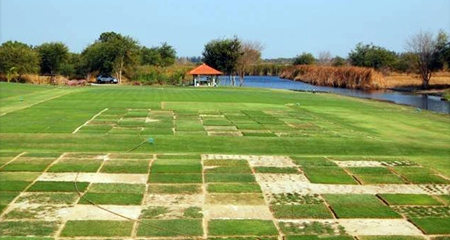Welcome to Golfnutter’s Blog – a new weekly commentary highlighting contemporary golfing issues, in Pattaya and beyond.
Ever wondered why certain putts don’t behave the way you expect? Why the pace of some greens appear fast, yet one hole later the pace slows significantly? What is it about putting surfaces in the tropics compared to the temperate climates of much of Europe, North America and Australasia? And why do local caddies say “Lohm” (down) or “Khung” (up) when there is no slope to be seen?
The answer is grass, or to be more exact, grain.
 Grass varieties being tested at the Asian Turfgrass Center’s research facility near Bangkok.
Grass varieties being tested at the Asian Turfgrass Center’s research facility near Bangkok.
Grain refers to the direction grass grows, or more precisely, the angle at which the blades of grass tend to lie. Grain can and does have a huge impact on the speed of the putt, especially with the types of Bermuda grass used in tropical climates. It will also influence direction. Some courses around Pattaya, such as Bangpra and Emerald, are more “grain obvious” than others. Whereas courses using thinner-bladed grasses on their putting surfaces, such as Mountain Shadow, Crystal Bay and Khao Kheow, have grain that is less apparent to the naked eye – but is there nonetheless.
Reading Grain
The direction of the setting sun, nearby mountains or water is irrelevant. Over here, there is one simple way to read grain; simply walk up to the hole you are playing and look in – it should tell you all you need know. Look at the inside rim of the hole – the cut-line where the edge meets the surface of the green. You will notice one-third of the hole’s circumference is ragged. Directly opposite this point is smooth by comparison.
The ragged look is caused by the grass’s tendency to grow and fray. If your ball is on the same side of the hole as this rough and ragged portion, you are putting into the grain. If your ball is located opposite, on the smooth-cut side, you are putting down-grain. The difference in putting speed between down-grain (lohm – sounds like loom), and up-grain (khung), is massive.
When putting cross-grain, expect the ball’s route to be influenced by the direction of the grain, especially when your ball slows as it approaches the hole.
Tell-tale signs around the hole at some courses may not be as obvious as others. If you can’t tell by looking at the rim of the cup – and I would be surprised – check the fringe – the grass on the edge of the green. Sometimes this grass is sufficiently long where you can see the direction of the grain simply by looking at it. This method works best mid to late afternoon, whereas the rim of the cup can tell all from early in the day.
Handling a downhill putt that is also down-grain
Many courses around Pattaya will give you this very challenge. The one thing you don’t want is to putt short as that is the worst possible outcome. The speed of your putt should be determined by two things – the length of your back-swing and where on the putter-face you hit the ball.
All putts, whether uphill, downhill or level, should be hit with an accelerating putter-head. If faced with a particularly fast putt, where you simply want to get the ball started on line, you can hit it following a short back-swing, or instead of the sweet-spot, use the toe of your putter. Whatever method is chosen, it is still a hit. Never use a decelerating stroke.
Now back to your 25-footer, downhill and down-grain; how do you get this ball to stop? It’s possible that you can’t, so try not to worry about it. Just ensure you do not leave it short by any distance greater than 18 inches.
Using the toe of your putter does have a dampening effect, but practise it first. Personally, when faced with this type of putt, where length dominates line, I focus solely on the feel of my right hand giving the ball a gentle tap. Normally, my hands apply equal pressure in my putting stroke, but not when putting downhill and down-grain.
As with putting generally, it is whatever works best for you. There is no right or wrong way regarding grip, stance or swing, so long as the ball is struck squarely with an accelerating putter-head.
Effective putting in Pattaya is absolutely dependent on reading greens correctly. A major part of this is to determine grain direction and the effect it has on line and length, particularly length. Achieve this and your total putts per round will drop.
How sure am I about all of this?
As any good caddie will tell you, “Ha sip, ha sip.”
Happy golfing!
Golfnutter




